CLOUDY DAY REFLECTIONS
Elisa Hendrey of Sound Beach snapped this surreal photo at Mt. Sinai Harbor on March 19 using her iPhone 6.
Send your Photo of the Week to [email protected]
CLOUDY DAY REFLECTIONS
Elisa Hendrey of Sound Beach snapped this surreal photo at Mt. Sinai Harbor on March 19 using her iPhone 6.
Send your Photo of the Week to [email protected]
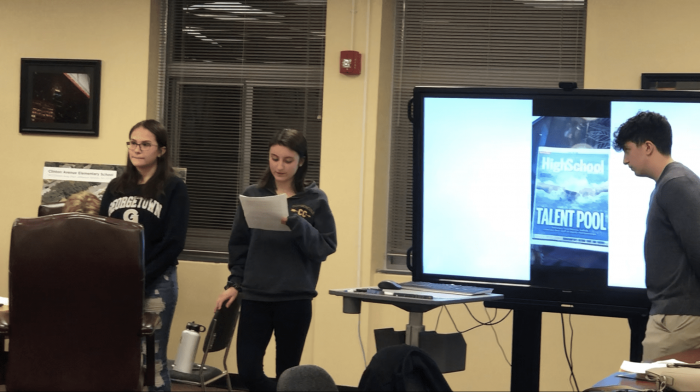
By Daniela Galvez-Cepeda
Imagine one person tapping another, and then this person tapping another, and this one in turn tapping another, and so on. The number of people tapped increases by 1 after every person. Now imagine one initial person tapping two other people, and then those two people tapping two others each, and so on. In this case, the number of people tapped multiplied by 2 after each pass.
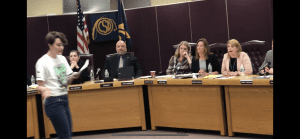
This is exactly the difference between linear and exponential growth, the former involving only one more person every time, while the latter doubling the number of people every time. Exponential growth is, thus, more powerful, and it is especially relevant when finding ways to connect with your community. At Comsewogue High School, students light torches of optimism in an exponential way during these times of uncertainty.
Right before schools were shut down, Comsewogue students, including myself, showed up at the board meeting March 2. We usually do that. This time, however, we took a little departure from our regular presentation about the latest news from our high school. We wanted to show our appreciation for Dr. Joseph Rella, the former superintendent of the Comsewogue School District who passed away Feb. 21.
I started our presentation. I did a hands-on activity involving all the people in attendance, asking one person to start a “tap one person” chain (that is, in a linear growth manner) and then a “tap two people” chain (that is, in an exponential growth manner). The exercise was very illustrative. People understood that information and values can be spread out much faster exponentially, rather than linearly. And this is exactly what Dr. Rella always showed — he spread so much caring and selflessness in exponential ways. We are now bound to broaden his legacy.
We wanted this meeting to be optimistic. It was our purpose to communicate to our administrators, our community and perhaps most importantly the younger students that we need to not only keep what Dr. Rella started for ourselves, but also pass it on and make it multiply and continue to radiate throughout our district. The tapping exercise was just an illustration, the framework to understand what we students have been doing following Dr. Rella’s teachings.
Excelling in Academics and Sports
Comsewogue senior Derek Order recognized the academic achievements of the senior class and introduced me as the valedictorian of the class of 2020 — an honor I carry humbly. Many students in the district not only perform at high levels academically but also devote so much of their time, energy and focus on volunteer activities in our community. For example, Derek and I go on activities with the Athletics for All group of students with disabilities.
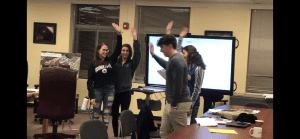
“Through Athletes Helping Athletes, I travel with these outstanding high school students helping out special athletes every month,” said Nicole Kidd, the Comsewogue teacher in charge of the athletes. “We have students from all types of sports encouraging our differently capable students to excel.”
“It seems like this kindness is something woven into our programs around here,” commented Matt DeVincenzo, the Comsewogue athletic director.
Furthermore, senior Jovanna Fusco celebrated the achievements that Comsewogue athletes had this 2020. A rousing round of applause went to senior Jake Vecchio, a Comsewogue swimmer who dedicates a large amount of his time off practice to help others. Vecchio not only placed at the state finals in swimming but won the coveted Section XI Good Sportsmanship Award.
“In addition to grinding out hours of practice daily, many of our athletes participate in different types of community service activities,” DeVincenzo said.
Arts
Then, junior Sarah Thomas invited everyone to the upcoming music and drama events while highlighting the importance of the arts in our community. Through the school’s productions of different plays and musicals, Comsewogue students express the idea of unity.
Both the music and drama departments in the high school have flourished because of the dedication presented here in our district. It is our steadfast belief that these students will continue to inspire empathy in the world with their voices and unmatchable talent. Along with the creativity culminating in their brilliant minds, the music in their hearts sits restlessly, just waiting to be passed forward exponentially.
Take Away
Finally, junior Melissa Levine wrapped the meeting up with a reflection about Comsewogue’s outstanding resilience — a colossal example of exponential growth. From the classroom to our neighborhoods, Comsewogue has always shown adaptability and strength, even in the most difficult times.
There is no denying that Dr. Rella ignited the torch that lit the path for success for all of our students. Because of him, Comsewogue has athletes being awarded scholarships and earning spots to compete in All County events, brilliant academic minds leaving the community ready to take on the greatest challenges, and talented performers who were taught to fall in love with the music of life again and again.
As an echo to the tapping activity, Melissa then encouraged everyone there, administrators, board members, parents, staff members and the whole community, to share the love Dr. Rella had for us, to pass it forward.
“One torch can show us the way, but an army of them can be a beacon in the night,” said Levine.
Dr. Rella taught us to take action, to grow the love, to pass optimism forward. Whether we are students, teachers, workers or stay-at-home parents, we are all connected in the same community and we are all responsible for making everybody in our district better. And we have to do it exponentially, so we can see it grow efficiently for all the members of the Comsewogue family. Let’s do it together.
Daniela Galvez-Cepeda is a senior at Comsewogue High School.
By Leah Chiappino
One of the most trying aspects of COVID-19 is the financial turmoil it has brought on both national and local business sectors. Financial adviser Michael Christodoulou of Edward Jones Investments in Stony Brook answered some commonly asked questions about how to secure investments and resources for small businesses, and the types of financial assistance offered through the recent stimulus package.
Q: What is your advice for people, especially those that are retired or nearing retirement, regarding their stocks and 401(k) plans?
A: For one thing, ask yourself this: When do you really need the money from your investment accounts, such as your IRA and your 401(k) or similar employer-sponsored plan? These are retirement accounts, so, depending on your age, you may not need to tap into them for 20, 30 or even 40 years. If so, your losses may be “paper” ones only for now and aren’t subjecting you to imminent financial jeopardy. This isn’t to minimize the effect this downturn will have on you, of course — it always takes time to recover lost ground, and there are no guarantees with investing. However, although past performance does not guarantee future results, it is useful to note that, over its long history, the U.S. stock market has typically trended in one direction — up — despite serious and sometimes lengthy declines such as we saw in the Great Depression and, to a lesser extent, the bursting of the dot.com bubble of the early 2000s and the financial crisis of 2008-09.
Nonetheless, you may have shorter-term goals — a wedding, down payment on a home, overseas trip, etc. — for which you need to save. For these goals, though, you wouldn’t want to touch your IRA or 401(k), anyway, as you’d likely face taxes and penalties. Instead, you’ll want your money invested in liquid, low-risk accounts that will be minimally affected, if at all, by declines in the financial markets. These vehicles might include Certificates of Deposit (CDs), money market accounts and even good old-fashioned U.S. savings bonds, all of which offer the protection of principal and can pay higher rates than traditional bank savings accounts.
Q: Should people stop contributing to retirement during this time?
A: Every investor has a different time horizon and risk tolerance. Depending on their time horizon and risk tolerance there may be a number of different recommendations.
For example, if a client has a longer-time horizon until retirement it may make sense to continue investing periodically in their retirement plan. But for someone who is looking to retire relatively soon, they might want to stop contributions or start saving those assets in low-risk accounts.
I highly recommend they work with their financial adviser in order to have a personalized strategy designed based on their goals for retirement.
Q: How would you advise small businesses go about applying for governmental assistance, especially through the federal stimulus bill?
A: Small businesses should work with their tax professionals/CPA and financial adviser in order to review their individual situation. I recommend they start by logging onto www.sba.gov/disaster. During this time, they should also be very cautious about scams.
Q: The economic effects of this virus are already enormous, and will get exponentially worse. How do you think people can financially cope if this crisis continues?
The Coronavirus Aid, Relief, and Economic Security Act (CARES Act) offers help for investors and small businesses. As we go through the coronavirus crisis, we are all, first and foremost, concerned about the health of our loved ones and communities. But the economic implications of the virus have also weighed heavily on our minds. However, if you’re an investor or a business owner, you just got some help from Washington, and it could make a big difference, at least in the short term, for your financial future. Specifically, the passage of the $2 trillion CARES Act offers, among other provisions, the following:
We’ll be in a challenging economic environment for some time, but the CARES Act should give us a positive jolt — and brighten our outlook.
Q: Do you have any information on how residents will know the exact number on their stimulus check for those above the $75,000 income threshold?
A: I would advise individuals to contact their tax professional/CPA. They will be able to give more accurate guidance based on their clients’ taxable situation and possible qualifications for the CARES Act direct payment program.
Q: What is your advice for those that have recently lost jobs and need to prioritize their loans? How can people cut back, and are there any specific loans that should be paid over others?
A: In the unfortunate event that you or a family member loses your job there are some easy steps to follow to help you better prepare yourself for this event. The federal government has taken a big step in protecting renters by issuing a 120-day moratorium on evictions from federally subsidized housing and property with federally backed mortgage loans. Some states have barred evictions for a few weeks. Please check with your landlord and or mortgage company.
Q: With stocks dipping, is now a good time to buy?
A: Before investing we recommend that investors understand their time horizon with the asset they are thinking about investing. What will that money be used for in the future? At what point in the future will you need the money?
For investors with a long-term outlook and time horizon, we remain confident that a rebound will take shape. It may take a while longer to materialize, but we think it will be robust and fueled by a return of confidence in the post-virus outlook. Long-term investors don’t need to capitalize on the pullback all at once but should consider opportunities to benefit from this decline. Consider:
We recommend you consult with a financial adviser in order to make sure you completely understand your level of risk and time horizon.
Q: Do you have any recommendations for a set amount people should have in savings in case of an emergency? What is the best way to do so?
A: I believe everyone should have an emergency fund. Unfortunately, there isn’t a universal dollar amount that applies for everyone.
If you don’t already have an emergency fund, take these first steps to prepare:
This is just a starting point. Depending on your age, your list may look considerably different. Your financial adviser can help you put together your cash flow analysis related to your financial goals and help you calculate how much cash you may need for your next unexpected event.
Q: How do you think people should go about negotiating with credit card companies and banks if they need relief?
A: If someone is facing some financial hardship, they should contact their credit card company or bank directly. In most cases these companies can provide guidance and options so the individual understands their options and can make a decision based on all the information provided to them.
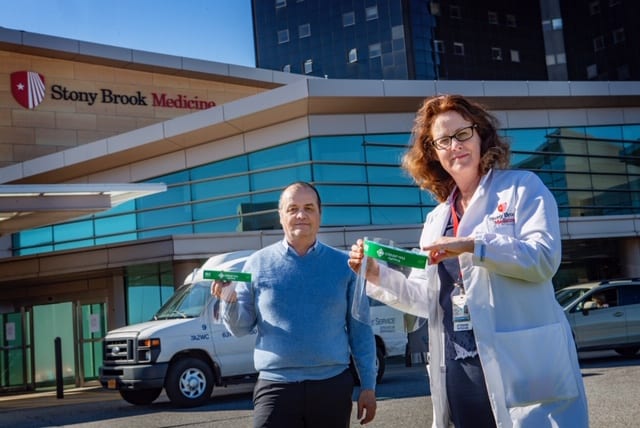
By Kyle Barr and David Luces
In other years, the first day of April dawning would have been a time for celebration and maybe a few pranks. This year, during the coronavirus crisis, not many were up for such jubilation.
In a daily call with reporters, Suffolk County Executive Steve Bellone (D) said as of today there were now 69 individual deaths from COVID-19 in Suffolk County. 25 of those individuals died in the past 48 hours and 16 in the past day. The vast majority of deaths were of people who had underlying medical issues.
“We are going to get through this but it is going to get worse before it gets better,” said County Executive Steve Bellone. “We all have the power to make this better by practicing social distancing. If you feel sick stay home.”
The total for all of New York was even more staggering, with Gov. Andrew Cuomo (D) announcing the morning of April 1 nearly 400 people have died in New York State in the span of 24 hours.
Cuomo compared it to the movie “Groundhog Day,” where the main character keeps experiences the same day over and over.
“When does it end? how does it end? I don’t know,” he said during his morning press briefing.
In Suffolk, the current number of people confirmed with the virus is 7,605. Currently over 25,000 have been tested, including 5,400 from the Stony Brook site in the South P lot as of Wednesday morning, Bellone said.
The County Executive also emphasized the 2020 Census, saying as we’re in the midst of this battle, we need to recognize the economic human service impacts.
“If we don’t do what we need to do we will be experiencing shortfalls in aid for the next 10 years,” Bellone said. “We have to make sure we’re getting those census documents filled out.”
The county executive added Child Protective Services continues to do house visits and they have done as many interviews as they can telephonically.
“The government does not close — we are here to deal with crises,” he said. “CPS is one of those they are continuing to operate.”
Stony Brook University Begins Drug Trials to Combat Coronavirus
In a COVID-19 briefing update, Stony Brook Medicine officials said that the hospital has begun a number of clinical trials designed to identify effective therapies for critically ill patients.
Remdesivir, an antiviral drug developed to treat two other RNA viruses, Ebola and Marburg, has been administered to two patients with severe coronavirus. The clinical trials on the drug are led by Dr. Sharon Nachman, chief of the Division of Pediatric Infectious Diseases at Stony Brook Children’s Hospital. Officials said the drug has appeared to be effective in treating COVID-19 in both China and Washington State.
Doctors will also be involved in a Regeneron-sponsored clinical trial on Sarilumab (Kevzara), a monoclonal antibody which blocks binding of interleukin-6 to its receptor. Sarilumab is already FDA approved for the treatment of juvenile rheumatoid arthritis, and more recently for the cytokine storm that accompanies the use of CAR-T cells for acute leukemia. The first Regeneron patient was recruited on March 30.
Stony Brook Medicine will soon be launching a clinical trial of donated, post-convalescent plasma from COVID-19 patients “very soon,” based on the level of antibody titers to SARS-CoV2 in the donor plasma. Serum or plasma therapy for infectious diseases dates to the 1890s, when serum made from immunized animals provided the first effective treatment for Clostridium tetani and Corynebacterium diphtheriae.
In addition, SBU professor Lily Mujica-Parodi has been part of a national effort to employ a wearable technology device called Oura to collect sufficient physiological data, and use deep learning algorithms to predict the onset of SARS-CoV2 infection. This type of device would be most productive and predictive in hospitals where there is a large number of healthcare workers in high-risk-for-infection roles.
LI Company to Begin New Face Shield Production.
Clear-Vu Lighting, a Central Islip-based design company, will begin manufacturing an order of 20,000 new face shields that will be deployed to Stony Brook University Hospital. Mass production is expected to start by early April. Clear-Vu Lighting is gearing up with an expectation to produce 40,000 faceshields per day and approximately 1.2 million per month. Production of face shields to Stony Brook will include supplies for Stony Brook University Hospital and all affiliated hospitals on Long Island.
Preventing a Possible Shortage of Ventilators
Due to the projections of the COVID-19 pandemic, Stony Brook University Hospital is suggesting it may be required to use a single ventilator for up to two patients in case there is a shortage once the number of patients is at its peak. In a Stony Brook Medicine research laboratory, medical professionals are working on a solution to ventilating multiple patients with one ventilator. Putting two patients on one ventilator requires matching patients with similar characteristics, such as sex, height, age and lung sizes, to avoid one patient being over ventilated and the other being under ventilated.
Stony Brook said researchers and doctors are examining the forces that cause unequal distribution of lung volumes and airway pressures, while using complex test models of diseased lungs. With this research, doctors are able to vary airway resistance and compliance and mimic acute respiratory distress syndrome-like conditions, which allows to test the use of inline valves and resistance devices to solve these problems.
Addressing the Growing Need for Additional Staff
To address potential staff shortfalls, the medical school is preparing to allow graduating students to volunteer on the front lines of the epidemic while awaiting the eventual surge of patients.
The Renaissance School of Medicine at Stony Brook University is allowing senior medical students to graduate in early April so they can begin their professional career as a physician at Stony Brook University Hospital. They will be able to work under the supervision of residents, fellows and attending physicians to address the growing number and complexity of patients being admitted to our hospital, precipitated by the COVID-19 pandemic. The graduates would then proceed to begin their residencies July 1.
On March 7 Kelli O’Hara and Sutton Foster joined forces for the first time in a double headline show at Stony Brook University’s Staller Center for the Arts for their 2020 Gala and, though no one knew it at the time, this would be the last show of the Staller Center season. Performing songs from their lengthy repertoires, both Tony-winning performers gave it their all to a sold-out crowd despite mounting precautions and fears surrounding COVID-19.
“I know this is a time of a little bit of nerves and wonder and mystery and anxiety … we want to give you a night away from that,” O’Hara said during her performance. The show went on, but out of an abundance of caution, the Gala’s reception was canceled. Little did O’Hara know, her comment about it being the last time audiences would be together, quickly became true. (see more photos at www.tbrnewsmedia.com)
Days later, on March 10, at the urging of Interim Stony Brook President, Michael Bernstein, the Staller Center announced that all March events were canceled. Bernstein’s bold and forward-thinking guided Staller Center Director, Alan Inkles, in his decision to cancel the Starry Nights concert, which was scheduled that same evening.
One week after that, Inkles also took the lead and stated that all events at the Staller Center through May 15 would be canceled. In the following days, other theaters and arts organizations, including the Metropolitan Opera, followed suit. In a time of considerable unease, theatre venues across the world have closed their doors to limit the spread of COVID-19.
“We were the first East Coast Arts Center that canceled shows for March last week and second in the country,” Inkles said. Indeed, the Staller Center decided to close before larger venues such as Broadway, The Metropolitan Opera House, and London’s West End.
Performances by the Russian National Ballet, America’s Got Talent finalist Diavolo, and the 30th-anniversary show of Bela Fleck & the Flecktones, among many others, are no longer coming to the Staller Center this season. “We are working with all of our artists and their managers in attempting to reschedule their shows in upcoming seasons and working together to find creative ways to minimize the financial hardships that appear imminent for these performers,” said Inkles.
Other canceled events include: three remaining MET Opera Live in HD screenings, the Spring Film Series, A Capella Live, Starry Nights, Jack Licitra: U are the Music!, the Emerson String Quartet, Carol Wincenc, and the Doo Wop Project. The Paul W. Zuccaire Gallery is also closed to all in-person visitors through the end of May.
The Box Office is closed to in-person visitors, but patrons are asked to call or email the box office at 631-632-ARTS[2787] or [email protected] with questions or concerns.
While Staller is offering credit or refunds for all ticketholders, generous sponsors, donors, and partners are offering their help, and many patrons have kindly donated their tickets back.
“We are certainly seeing some great humanity in the art world as everyone scrambles to help each other,” Inkles said.
Stay tuned for announcements on the Staller Center’s 2021-22 Season at www.stallercenter.com and visit www.stonybrookfilmfestival.com for information on this July’s 25th Annual Stony Brook Film Festival.
All photos by Millie Elangbam/Staller Center
‘Life throws challenges and every challenge comes with rainbows and lights to conquer it.’
― Amit Ray
WELCOME SPRING!
Photographer Mimi Hodges of Sound Beach ventured out in her backyard on March 15 to capture images of these beautiful flowers, “reasons for joy,” and which she now shares with you as we welcome spring to our neck of the woods.
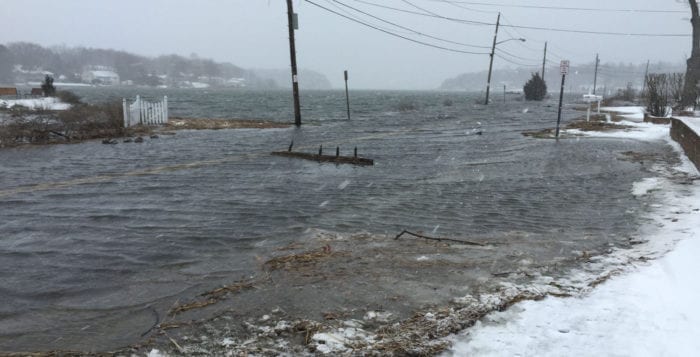
By Sapphire Perera
I haven’t been to school in 13 days and I don’t know when I’m going back. Many of the shelves in the grocery stores are empty, toilet paper is sold out and everyone is self-quarantining. This panic and fear are due to the outbreak of the most current pandemic — the coronavirus, also known as COVID-19. This new strain of coronavirus originated in China and has spread globally. While it seems improbable that there’s a connection between pandemics and climate change, past pandemics prove otherwise. This connection shows us that for every action, there is a reaction.
Interview with Dr. Lisa M. Chirch
Dr. Lisa M. Chirch is a associate professor of medecine at the University of Connecticut who specializes in infectionous diseases.
SP: Sapphire Perera; LC: Lisa Chirch
SP: Due to habitat loss, there is evidence of vector transference between wild animals and livestock. Do you think this will eventually involve household pets, which may be more susceptible to loss of native immunity?
LC: Good question, and very important to those of us with household pets we adore as part of the family. To date, it is unclear whether viral infections such as COVID-19 can infect dogs and cats, or whether they would become ill if infected. It really depends on the specific organism and how they infect, which tissues are targets, which receptors are used for cell entry, etc. Certainly, the potential for domestic animals to be affected is present, and we should probably be taking similar precautions with our beloved pets as with our family members whom we want to protect.
SP: Extreme changes in global weather patterns are one factor of climate change. With increases in climate change and warmer weather, do you feel that future pandemics will originate in places such as North America and Western Europe instead of Asia and Africa, as they did with the 1918 Spanish flu?
LC: Throughout history, pandemics have originated from sites all over the world. Pandemics originate when humans are exposed to “novel” organisms we have never seen before, exposing populations without immunity. Over time these have frequently been related to the animal/human interface in some way, with organisms “jumping” from one species to another, and in the worst-case scenario, becoming efficient at human-to-human transmission. So, to the extent that climate change drives animals and humans further together, it drives the possibility of further epidemics. Importantly, climate change has more immediate and tangible effects on infectious diseases in humans that have been recently notable, such as the appearance of certain mosquito-borne arboviruses in the southern U.S. (dengue, chikungunya, Zika), and tick-borne illnesses migrating northward as well, with the associated northward movement of the tick species that carry them.

Climate change has made our winters shorter and the weather unseasonably warm. This global increase in temperature is just one of the causes of climate change, and directly affects vectors i.e., disease-carrying organisms such as mosquitoes, ticks, fleas and flies. These vectors spread diseases such as malaria, dengue fever, West Nile virus, and yellow fever which are some of the worst pandemics. The global increase in temperature is driving these vectors further from the equator and into the northern hemisphere. For instance, the United States has seen increased cases of dengue and malaria in Florida, California and Texas. Europe and the U.S. may soon be subjected to the same epidemics that plague people in equatorial climates. In contrast, other regions that usually struggle through the worst of the pandemics and epidemics will see a decrease in the number of outbreaks.
The increase in temperature, rainfall and humidity also creates more breeding grounds for vectors, leading to the easier spread of diseases. This was exemplified by India’s monsoon season from 1994 to 1996. The excessive monsoon rainfall and high humidity in the Punjab region of India led to an increase in malaria epidemics in places such as Rajasthan, Manipur, Nagaland and Haryana. Recent studies have shown that El Niño has actually increased the malaria epidemic risk in India by about fivefold. El Niño scientists have discovered increases in incidences of cholera, Zika, chikungunya, and hantavirus with El Niño occurrences.
Deforestation is another cause of climate change that brings vectors closer to urban communities. Sonia Shah, the author of the book “Pandemic,” says in her article in The Nation, “When deforestation threatens the survival of wild species, there are more opportunities for animal microbes to adapt to human bodies.” One example from the many pandemics that we’ve had in the past is the Ebola outbreak. In places such as Central and West Africa, there have been serious deforestation and habitat losses for bats, which are vectors for Ebola. These bats started inhabiting places closer to urban populations which, in turn, increased the likelihood of Ebola outbreaks. Studies in 12 countries have actually shown that it is twice as common to have vector mosquitoes in deforested areas than in intact forests.
Apart from bringing vectors close to human communities, climate change is introducing prehistoric diseases to mankind. In 2016, the Russian city of Yakutsk saw the outbreak of anthrax during a heat wave in Siberia. The thawing permafrost soil there released long-dormant bacteria and viruses that had been trapped in the ice for centuries. One 12-year-old boy died and at least 20 people were hospitalized from infection. Scientists speculate that more diseases lie beneath the ice and with the rising global temperature, we may see the reemergence of diseases such as smallpox, the bubonic plague and the 1918 Spanish flu.
Since January, there has been a significant universal decrease in social and economic activity. The results from this are astounding. First of all, since there has been slower economic activity, there has been a drop in carbon dioxide emissions. In Hubei province in Central China, there has been a drop in air pollution as the cloud of nitrogen dioxide evaporated in February. Italy saw similar results in its environment pertaining to nitrogen dioxide levels. Additionally, the once-murky canal water in Venice is now so clear that you can see the fish below. In countries all over the world, we are seeing changes like this. Unfortunately, it’s taking a pandemic brought about by climate change to reduce climate change.
Sapphire Perera is a junior at Port Jefferson high school. The “Turtle Island,” as the name for this ongoing column refers to the Native American mythology about North America existing on the back of a great turtle that bears every living being on its spine.
PINK TWILIGHT
Dawn Olenick of Baiting Hollow was driving along Sound Avenue in Riverhead on the night of Feb. 6 when she captured this stunning sunset.
Send your Photo of the Week to [email protected]
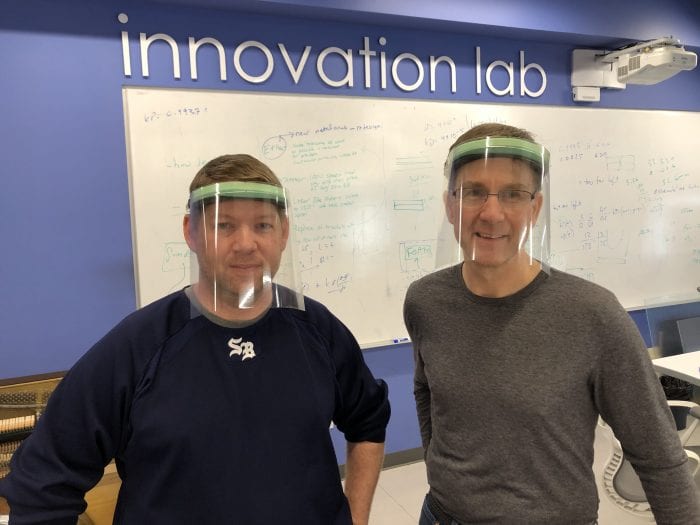
In response to the COVID-19 pandemic and shortage of materials hospitals are facing, a small group of high school students and faculty from The Stony Brook School have come up with a solution that can be produced in their STEM lab and, soon, across the country — protective face shields at a fraction of the originally expected time and cost, according to a press release from the private school.
Stony Brook University Hospital recently reached out to the surrounding community to secure usage of 3D printers to produce face shields. The hospital, whose design would take approximately three and a half hours per shield, sought to commision 5,000 shields per usable printer.
When the Stony Brook School was alerted of this, Stan Winston, director of STEM Education, and Jeremy Donovan, STEM teacher, thought they could come up with a much more efficient solution with the help of their highly-skilled students. In a little over 24 hours, Winston had presented the idea to his classes — in virtual classrooms since the outbreak of the pandemic — and a prototype was made.
After three major roadblocks were overcome by the students, a final solution was found. In lieu of a time-intensive 3D print, a face shield constructed with the STEM lab’s laser cutter could be made in just 35 seconds. With the new design and process, about 100 can be made each hour at a cost of under 50 cents each, and the school will be producing at least 5,000 of them for SBU Hospital.
Students instrumental in coming up with this solution were Stony Brook School sophomores Cole Spier and Tiger Winston and junior Ethan Magnuson.
“Our students are committed to serving the world with their character and leadership,” Stan Winston said. “With their years of problem-solving experience in our STEM courses, along with a huge community effort, we have reached a great solution to a pressing issue facing our country today.”
Stony Brook University Hospital has accepted the school’s design and proposal, according to The Stony Brook School.
During challenging times like these, the Comsewogue School District reacted to be fully prepared to not only provide and keep its classes and academic standards at a high level but also to keep the students’ social and emotional well-being stable despite no longer being in the school buildings.
The administration, staff, students and community saw fit to have educational packets and more in place while the upper grades were provided with Chromebooks and resources online available before school was closed. The technology department was in close contact and continues to be communicating with everyone on a daily basis with updates and more.
“I was happy to receive additional training available up to the very last day,” said Camie Zale, a special education teacher.
“Teachers and students are comfortable with using technology and communicating with various websites and apps on a normal basis,” said Andrew Harris, a teacher at the middle and high school. “Unfortunately, I’m nowhere as savvy as most of these students who have grown up with this technology. If I ever have any problem, I can ask any of my students who usually solve it in a matter of seconds … they are amazing.”
Don Heberer, district administrator for instructional technology, said the 1:1 take-home Chromebook program in the high school and classroom carts at John F. Kennedy Middle School had allowed students and teachers to become comfortable with using the technology for education.
Melissa McMullan, a sixth-grade teacher in the middle school, said the school did a great job getting Chromebooks into kids’ hands. The process, she said, has been tricky to find what works and what doesn’t on an online space.
“The kids and I will solve the need for distance learning together like we always do,” she said.
Students in the elementary schools have grade-level packets posted online along with hard copies sent home. The district is also providing support to both teachers and parents remotely on using the technology.
”Comsewogue has always prided itself on being innovative and willing to try something new,” Heberer said. “We know that it will be a challenging change for everyone; however, Comsewogue staff has worked hard to provide the students, teachers and community resources during this period.”
The Comsewogue district has taken to online as well for interteacher-related processes. Harris said teachers received a message from the Pupil Personnel Services department that they will hold upcoming annual meetings on Google Hangouts as part of their annual review process. It has taken time and effort but he feels he has become comfortable and “up to speed” with the various programs.
“For me, I am learning as I go,” Harris said. “The first day I mostly communicated the way I was most familiar with — I picked up the phone and called most parents to let them know what was going on with their child’s education. From there I switched to text messages, and finally have been using Google Classroom and more as I get better.”
After checking in with several of the students, Harris said many teachers realized they were perhaps giving too much work. One parent communicated that her daughter was working from early morning until about 5 p.m. on her assignments and starting to stress out.
“I think many of the teachers didn’t want the students to feel like they were on vacation and get complacent,” said Joe Caltagirone, a teacher at the high school.
Harris said he wanted his very first assignment to be something light and be beneficial to his students and their families. He posted a YouTube video on how to do Box Breathing, a technique of taking slow, deep breaths to relieve some stress and help concentrate.
“I know people are highly stressed so I asked that the student watch this video first,” Harris said. “I also requested that they teach members of their family how to do it. I know from experience when you teach others you become very proficient at what you’re teaching. I asked them all to comment on how it made them feel.”
Harris, also a yoga instructor, said that breath work is easy to learn and perhaps the best thing people can do in these stressful situations.
Having said all of this, there are many in the Comsewogue community that may not be as comfortable as students are with technology, though there are many people willing to help distribute food and other resources to our senior citizens.
“The problem is that they may not know that there is help out there. Where many of us can easily access social media sites, many of these seniors don’t have the ability to do so,” said Ed Garboski of the Port Jefferson Station/Terryville Civic Association.
“Currently, I’m trying to find a way to bridge that gap,” said Harris. “We are trying to put together an electronic way to have our students write letters to the senior citizens who are being quarantined at local facilities. If we have to, we will have the letters printed and distributed to those seniors directly or through the facility’s printer, so they are not compromised.”
Superintendent Jennifer Quinn stated that the whole staff is committed to doing whatever is necessary to make sure the students continue to get everything they need to have a great education, and much more.
Information and quotes provided by Andrew Harris
By Deniz Yildirim
Like the rest of New York, Comsewogue School District is facing unprecedented challenges with courage and teamwork. Following Gov. Andrew Cuomo’s (D) orders, all six of the district’s schools were closed on Monday, March 16, for a tentative two-week period. Administrators and teachers worked hard to create packets and uploaded countless resources onto the district’s website so students can continue their education at home.
Preparing work for over 5,000 students with numerous and distinct needs such as learning disabilities and language barriers could only be completed with hard work and collaboration. Reading teachers, English as second language teachers, teaching assistants and even special area teachers like music teacher Ellen Rios came together to create comprehensive packets that were sent home with students on Friday, March 13. Parents could come in person to pick them up if their child wasn’t in school to get it themselves.
Superintendent Jennifer Quinn has been regularly calling parents with updates and also informed families that the district is even willing to lend out its Chromebooks to students who couldn’t otherwise access the online learning tools.
“This is a scary time for everyone and our students’ health comes first. We want to share what we have to make them feel safe and help them continue to learn,” said Quinn. “Families are advised to call the district so they can prepare the appropriate materials and ensure a smooth and sanitary pick up.
In addition to student work, Comsewogue is continuously posting statements on its website (in English and Spanish) in order to keep families informed. One such notice comes from Robert Pearl, the district’s new administrator for Pupil Personnel Services and Micheala Finlay-Essig, the assistant director of PPS; they have been rescheduling important meetings regarding student services that will now be “teleconferencing” meetings through Google Meet. The instructional technology department led by Don Heberer has never been more critical and everyone can testify to the key role they are playing.
“We’re here to help our students, teachers and community,” Heberer said. “We have been supporting our teachers through technology professional development, so the teachers can support our students’ learning. We are updating the district website and mobile app daily to keep our community informed and provide vital resources.”
Comsewogue graduate, parent and now teacher Kristina Fowler said she’s never been prouder of her community. Fowler has a unique perspective because she’s been in everyone’s shoes, so it’s particularly meaningful to hear her say that Comsewogue is going above and beyond her expectations. She supports her two sons, fourth-grader Kingston and second-grader Miles and lets them “play” with their friends via FaceTime. Most recently, Kingston and Kristina helped classmate Liam Schneph with a question he had about his new hamster.
“It’s so important to stay connected and let kids be kids,” she said. “Comsewogue won’t be stopped by COVID-19.”
Deniz Yildirim is a librarian at the Terryville Road Elementary School
